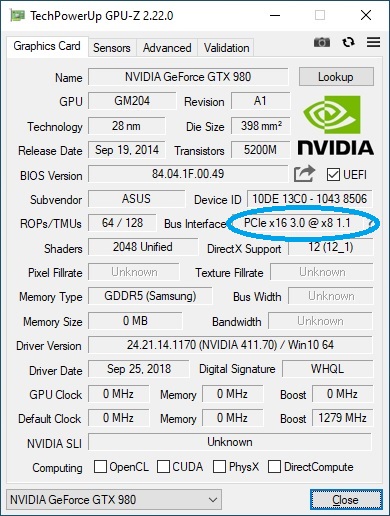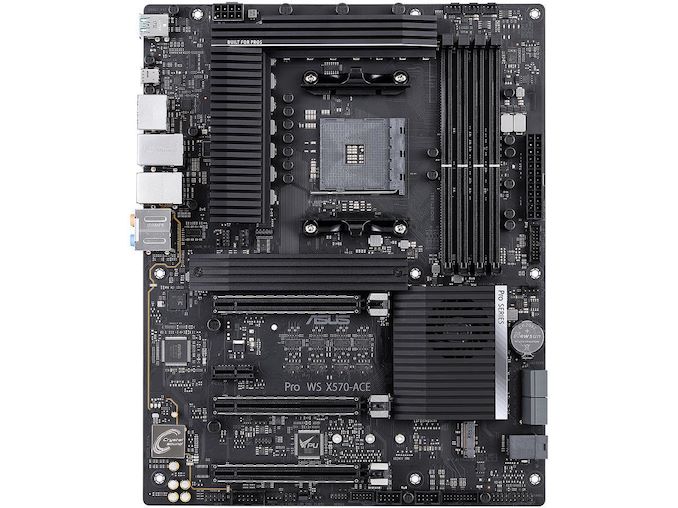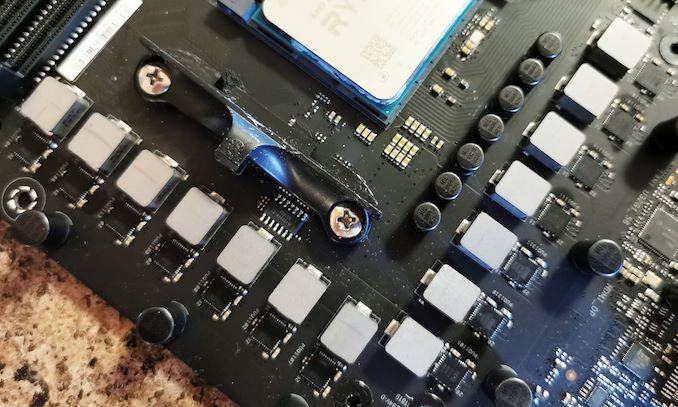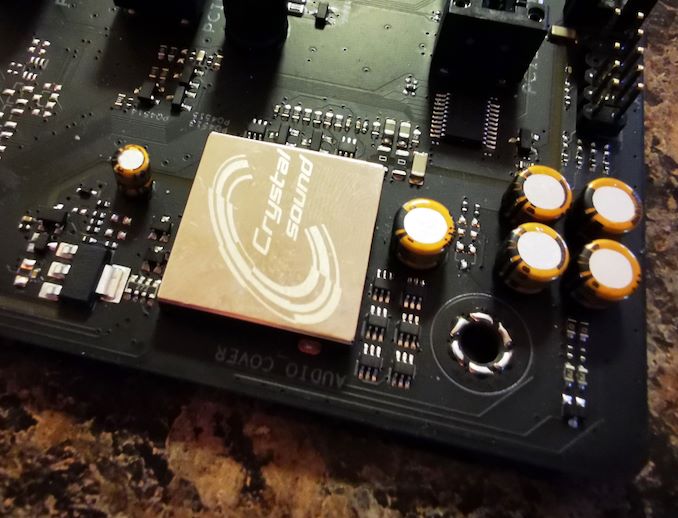The ASUS Pro WS X570-Ace Review: x8x8x8 with No RGB
by Gavin Bonshor on August 12, 2019 9:00 AM ESTVisual Inspection
Setting its sights on professional and workstation users, the ASUS Pro WS X570-Ace encompasses a strict and elegant design without the plethora of RGB LEDs that plenty of other models do. Instead, the Pro WS X570-Ace uses straight angled black aluminium heatsinks with the fins aligned horizontally on an all-black PCB. This includes the power delivery heatsink, the actively cooled X570 chipset heatsink, and the single PCIe 4.0 x4 M.2 heatsink. Located around the edge of the board are six 4-pin headers which support one CPU fan, one AIO pump connector, and four chassis fans. At the bottom of the PCB is an ASUS NODE connector hardware interface controller. While there aren't many products out which support this, InWin is currently developing an OLED screen which can display statistics such as CPU temperature, and fan speeds.
In the top right-hand corner of the board is four memory slots with support for DDR4-4400 memory, and is capable of housing up to 128 GB of system memory. A lot of vendors mention support for ECC memory in its specifications, but the ASUS Pro WS X570-Ace has validated support for ECC memory (and non-ECC). This means users can build an X570 based workstation with all the benefits of ECC memory including options in the firmware for memory scrubbing and memory addressing; this ultimately comes down to processor support including the AMD Ryzen Pro models. The WS X570-Ace also benefits from ASUS's OptiMem which is essentially a method of making the memory trace layout more efficient and can help to reduce memory latencies when overclocking, as well as potentially increase memory frequency yield too.

The bottom full-length PCIe 4.0 slot on the Pro WS X570-Ace operates at x8
One of the main features that sets this model apart from the rest of the current X570 product stack is in its PCIe 4.0 support. The ASUS Pro WS X570-Ace has three full-length PCIe 4.0 slots which operate at x16, and x8/x8, and the bottom slot operates at x8 powered through the chipset. All three full-length slots include a coating of metal armor re-inforcement, and for users looking to use a dedicated soundcard or another networking card, ASUS also includes a single PCIe 4.0 x1 slot.
Although the ASUS Pro WS X570-Ace is more geared towards workstation users, its power delivery is more than suitable for enthusiasts looking to overclock Ryzen 3000 processors too. It has a 12+2 phase design that is controlled by an ASP1405I running at 6+1 which is a custom variation of an International Rectifier IR35201 PWM controller. ASUS has opted to use teaming as opposed to doubling up phases for better transient response across its X570 models. As a result of this, the CPU VCore section is running 12 x IR3555 60 A power stages and the SoC is using 2 x IR3555 60 A power stages which are teamed together in pairs to create the 6+1 design. Delivering power to the processor is a single 8-pin 12 V ATX CPU power input.
Moving onto the storage capabilities of the ASUS WS Pro X570-Ace, we have two PCIe 4.0 M.2 slots with the top M.2 slot allowing for both PCIe 4.0 x4 and SATA drives to be used which includes an M.2 heatsink. The M.2 slot located at the bottom of the board only has support for PCIe 4.0 x2 drives, although this model does include a U.2 PCIe 3.0 x4 slot, and four SATA ports with support for RAID 0, 1, and 10 arrays.
The ASUS Pro WS X570-Ace uses a Realtek ALC1200S HD audio codec which provides five 3.5 mm audio jacks, and an S/PDIF optical output. On the Realtek ALC1200S HD audio codec is an EMI shield and is supported with six gold Japanese audio capacitors. The audio PCB is also separated from the rest of the board's componentry.
On the rear panel are two Ethernet ports, one being Realtek RTL8117 and the other an Intel I211-AT. ASUS has included four USB 3.1 G2 Type-A, one USB 3.1 G2 Type-C, and two USB 3.1 G1 Type-A ports, as well as a pair of video outputs including an HDMI 1.4b, and DisplayPort 1.2. Touching on the Realtek RTL8117 Gigabit NIC, this is supported by the ASUS Control Center Express which is a server-focused application which also doubles up as a management controller. It allows for out-of-band management and hardware-level control.
What's in the Box
Included in the box is a very fundamental accessories bundle which includes four SATA cables, an M.2 screw package, a driver and software installation disc, an I/O shield, and a user manual. The most noteworthy accessory in the bundle is an ASUS VGA holder designed to eliminate sagging in heavyset graphics cards, which can not only damage the card but the PCIe slot too if it isn't secured properly.
- 4 x SATA cables
- Rear I/O shield
- 1 x ASUS VGA holder
- 1 x M.2 screw package
- 1 x Installation disk
- User manual















110 Comments
View All Comments
Hul8 - Wednesday, August 14, 2019 - link
APUs (at least 1000 and 2000 series) don't have ECC capability.Hul8 - Wednesday, August 14, 2019 - link
This is provably due to them being separate designs from the modular one of mainstream Ryzen/Threadripper/EPYC; The modular chips *had* to have ECC built in them to support it on EPYC, but AMD has very little reason to dedicate any die area or design resources to it on APUs.Zan Lynx - Friday, August 16, 2019 - link
The APUs don't have ECC support because the Vega does not support it. Since there's a unified memory system, half and half wouldn't work.GreenReaper - Tuesday, August 13, 2019 - link
They support it, but without motherboard support for reporting of status and error handling, it's hard to have any confidence over whether it's actually working.StoltHD - Friday, July 10, 2020 - link
You need to use unbuffered ecc, not registered ecc, so you need to seach a little to get the right sticks, but I run 64GB ECC 2666Mhz at 3000Mhz with my 3900X at 4100Mhz (max speed all core I have managed with stock cooler are 4300Mhz all core and 3000Mhz on ram (no cooling on the ram)CityZ - Tuesday, August 13, 2019 - link
How well will the x8 slot from the chipset work if the chipset itself has only a x4 connection to the CPU and memory?tristank - Tuesday, August 20, 2019 - link
Thats exactly the same question I asked myself.StoltHD - Friday, July 10, 2020 - link
For most calculations and "just for display output" it works welll, but it does not work that good if you have work that need high speed between cpu-gpu ...So for a high perfomance storage WS it can work well, since you can add a Hyper M.2 to the first PCI-E slot for full 16x PCI-E v.4 speed using 4x PCI-E V4 NVME SSD's, but then you can not utilize the second x16 slot ...
If you need 2x or more full 16x PCI-E speed, you need to go Epyc ...
croc - Wednesday, August 14, 2019 - link
I cannot consider any amd x570 MB a WS class MB when it is limited to four DIMMs... The lack of 10GBs network interface has been mentioned. Haven't seen anyone mention the lack of a fourth PCIe x 16 slot or the paucity of of x 4 slots. The only thing that is workstation class on this motherboard (or, indeed across the entire x570 range) is the price. Intel server boards (Tyan, Supermicro) offer much more for similar price. CF Supermicro x11dai-n @587 USD from Amazon...StoltHD - Friday, July 10, 2020 - link
Add the price of the Xeon CPU ...If you go that way you can get a 2x Epyc system for near half the price of a 2x xeon system ,,,
There are epyc motherboards out now with ALL (7-slots) pci-e x16 v.4 ...
(Asrock ROMED8-2T)